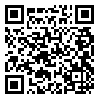Volume 8, Issue 3 (7-2020)
JoMMID 2020, 8(3): 118-114 |
Back to browse issues page
Download citation:
BibTeX | RIS | EndNote | Medlars | ProCite | Reference Manager | RefWorks
Send citation to:



BibTeX | RIS | EndNote | Medlars | ProCite | Reference Manager | RefWorks
Send citation to:
Kazemirad E, Latifi A, Mobedi I, Akmali V, Mirjalali H, Mowlavi G. Helminth Parasites of Bats (Chiroptera: Rhinopomatidae Bonaparte, 1838) from the Persian Gulf Coastal Area. JoMMID 2020; 8 (3) :118-114
URL: http://jommid.pasteur.ac.ir/article-1-276-en.html
URL: http://jommid.pasteur.ac.ir/article-1-276-en.html
Elham Kazemirad 

 , Alireza Latifi
, Alireza Latifi 

 , Iraj Mobedi
, Iraj Mobedi 

 , Vahid Akmali
, Vahid Akmali 

 , Hamed Mirjalali
, Hamed Mirjalali 

 , Gholamreza Mowlavi *
, Gholamreza Mowlavi * 




 , Alireza Latifi
, Alireza Latifi 

 , Iraj Mobedi
, Iraj Mobedi 

 , Vahid Akmali
, Vahid Akmali 

 , Hamed Mirjalali
, Hamed Mirjalali 

 , Gholamreza Mowlavi *
, Gholamreza Mowlavi * 


Department of Medical Parasitology and Mycology, School of Public Health, Tehran University of Medical Sciences, Tehran, Iran
Abstract: (3907 Views)
Introduction: Bats are natural reservoir hosts of several zoonotic infections. Few studies have demonstrated gut helminth community parasite in bats. In the present study, we investigated two intestinal helminths of two bat species, Rhinopoma muscatellum, and Rhinopoma microphyllum, from Hormozgan province, southern Iran. Methods: We received digestive tracts of 56 Rhinopoma bats previously captured by several biologists. The specimens were precisely dissected and examined for the parasitic helminths. The collected helminths were cleared in the lactophenol and identified using reliable morphological and morphometrical key references. Result: In this study, 44 R. muscatellum and 6 R. microphyllum species were examined, among which 15 (26.7%) had infections with parasitic worms. Lecithodendrium sp. and Castoria sp. were identified in the digestive tract of eight and four individually examined R. muscatellum bats, respectively. Also, in three R. microphyllum bats, a few spirurid nematodes with incomplete structures were detected. Conclusion: We, for the first time, identified Lecithodendrium sp., Castoria sp., in R. muscatellum from south of Iran. Due to the insectivorous biological trait of bats, the most abundant helminth was Lecithodendrium sp. Further study with more samples is needed to describe the helminths fauna of microbats in Iran taxonomically.
Type of Study: Original article |
Subject:
Host-pathogen interactions and susceptibility factors
Received: 2020/09/26 | Accepted: 2020/07/20 | Published: 2020/12/26
Received: 2020/09/26 | Accepted: 2020/07/20 | Published: 2020/12/26
References
1. Macdonald, D. The Encyclopedia of Mammals. New York: Facts on File. 1984. 800.
2. Fenton, M. Brock. Bats. New York: Checkmark Books. 2001; 122-4.
3. Kafaei S, Akmali V, Sharifi M. Using the Ensemble Modeling Approach to Predict the Potential Distribution of the Muscat Mouse-Tailed Bat, Rhinopoma muscatellum (Chiroptera: Rhinopomatidae), in Iran. Iranian J Sci and Technol Trans A Sci. 2020; 25 (1-2): 1337-48. [DOI:10.1007/s40995-020-00953-w]
4. Akmali V, Farazmand A, Darvish J, Sharifi M. Phylogeography and taxonomic status of the greater mouse-tailed bat Rhinopoma microphyllum (Chiroptera: Rhinopomatidae) in Iran. Acta Chiropt. 2011; 13 (2): 279-90. [DOI:10.3161/150811011X624767]
5. Kafaei S, Sharifi M, Akmali V. Population Genetic Structure and Phylogeography of the Small Mouse-Tailed Bat, Rhinopoma muscatellum Thomas, 1903 (Chiroptera: Rhinopomatidae) in Iran Inferred from Mitochondrial DNA. Acta Chiropt. 2020; 22 (1): 29-40. [DOI:10.3161/15081109ACC2020.22.1.003]
6. Allocati N, Petrucci AG, Di Giovanni P, Masulli M, Di Ilio C, De Laurenzi V. Bat-man disease transmission: zoonotic pathogens from wildlife reservoirs to human populations. Cell Death Discov. 2016; 2 (1): 1-8. [DOI:10.1038/cddiscovery.2016.48]
7. Yan-Rong Guo, Qing-Dong Cao, Zhong-Si Hong, Yuan-Yang Tan, Shou-Deng Chen, Hong-Jun Jin, et al. The origin, transmission and clinical therapies on coronavirus disease 2019 (COVID-19) outbreak - an update on the status. Mil Med Res. 2020; 13;7 (1): 11. [DOI:10.1186/s40779-020-00240-0]
8. Wang LF, Anderson DE. Viruses in bats and potential spillover to animals and humans. Curr Opin Virol. 2019; 3 (4): 79-89. [DOI:10.1016/j.coviro.2018.12.007]
9. Angoma DM, Flores GM, De la Cruz JC, Chancahuaña CC, Iannacone J. Helminth parasites of bats (Chiroptera, Phyllostomidae) in the Department of Junin, Peru and Check list of records made in Peru. Revista del Museo Argentino de Ciencias Naturales nueva serie. 2020; 22 (1): 57-73. [DOI:10.22179/REVMACN.22.675]
10. Haelewaters D, Pfliegler WP, Szentiványi T, Földvári M, Sándor AD, Barti L, et al. Parasites of parasites of bats: Laboulbeniales (Fungi: Ascomycota) on bat flies (Diptera: Nycteribiidae) in central Europe. Parasit Vector. 2017; 10 (1): 96. [DOI:10.1186/s13071-017-2022-y]
11. DeBlase Anthony F. The bats of Iran: systematics, distribution, ecology. Fieldiana Zool, 1981. p. 861. [DOI:10.5962/bhl.title.3206]
12. Dietz C. Illustrated identification key to the bats of Egypt. Electronic publication, version. 2005 Dec 21; 1.
13. Skrjabina E, S.: Helminths of sturgeons. Publishing house 'Nauka'. 1974. 1-168. Russian.
14. Hemmati F, Rezazadeh E, Kiabi BH, Hemmati L, Molavi G, Radd EK, et al. Parasites of the Lesser Mouse-Eared Myotis, Myotis blythii (Chiroptera, Vespertilionidae), from Zanjan Province, Northwest Iran. Comp Biol. 2013; 80 (2): 312-3. [DOI:10.1654/4627.1]
15. Lord JS, Parker S, Parker F, Brooks DR. Gastrointestinal helminths of pipistrelle bats (Pipistrellus pipistrellus/Pipistrellus pygmaeus) (Chiroptera: Vespertilionidae) of England. Parasitology. 2012; 139 (3): 366-74. [DOI:10.1017/S0031182011002046]
16. Ashour AA, Ahmed SE. Studies on the helminth parasites of birds from Egypt: 1-trematoda and cestoda. J Egypt Soc Parasitol. 1996; 26 (1): 207-16.
17. Sawada I, Harada M, Wu Y. Cestode parasites of some bats from the People's Republic of China. Parasitol Int. 1998; 47 (2): 149-56. [DOI:10.1016/S1383-5769(98)00013-0]
18. Rosskopf SP, Held J, Gmeiner M, Mordmüller B, Matsiégui PB, Eckerle I, et al. Nycteria and Polychromophilus parasite infections of bats in Central Gabon. Infect Genet Evol. 2019; 68: 30-4. [DOI:10.1016/j.meegid.2018.11.022]
19. Horvat Ž, Čabrilo B, Paunović M, Karapandža B, Jovanović J, Budinski I, et al. Gastrointestinal digeneans (Platyhelminthes: Trematoda) of horseshoe and vesper bats (Chiroptera: Rhinolophidae and Vespertilionidae) in Serbia. Helminthologia. 2017; 54 (1): 17-25. [DOI:10.1515/helm-2017-0009]
20. Hall JE. Some lecithodendriid metacercariae from Indiana and Michigan. J Parasitol. 1960; 46 (3): 309-14. [DOI:10.2307/3275492]
Send email to the article author
| Rights and permissions | |
 |
This work is licensed under a Creative Commons Attribution-NonCommercial 4.0 International License. |

This work is licensed under a Creative Commons Attribution-NonCommercial-NoDerivatives 4.0 International License.




